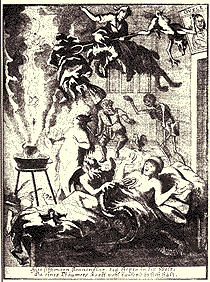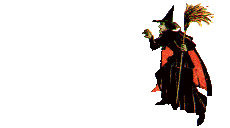Mere imaginings?

Witchcraft as a bad dream,
from the German translation of John Webster,
Untersuchung der vermeintlichen und
sogenannten Hexereien (Halle,1716)

That the witchcraft experiences of accusers proceded largely from the imagination was hardly a new theme, having been present throughout the entire period of the trials, but it gained especial force as the trials drew to a close. Enlightenment thinkers depicted popular beliefs, and by extension those of their religious and political opponents, as based on nothing more solid than a fevered imagination.
A classic early satire on the belief in witchcraft and other extraordinary phenomena was L?Histoire des Imaginations Extravagantes de Monsieur Oufle. This celebrated work portrayed what happened to Monsieur Oufle who had read too many strange books about demons and the supernatural, so that he is easily fooled by false appearances and vain imaginings. It seems to have been a very early meta-commentary on the power of fantastic literature. Sometimes attributed to its publisher, Nicolas Gosselin, it was probably written by the Abbé Laurent Bordelon (1653-1730). It was published in Paris, in 1710, and promptly translated into English (see below for details of the microfilm).


Monsieur Oufle is frightened by a monster in the village and by demons
dragging people away.

Here, the Fool shows to Oufle the Devil being worshipped at the sabbat,
in a scene
clearly based on the serious portrayals of the demonic orgy in demonological
works.
The critique of the witchcraft beliefs as based on nothing more substantial than the imagination gained some of its force from the new psychology of "sensibility", which became increasingly influential during the eighteenth century, but it had its roots in the mockery of vulgar credulity. The educated elite withdrew support, not necessarily from all belief in the supernatural but from the more improbable stories of the demonologists and especially from the folk semiotics of witchcraft accusers. The Devil was reduced to the status of a psychological threat rather than having a separate and dangerous existence in the physical world. However, this shift in elite perceptions should not be seen as necessary or inevitable. Not all educated Europeans accepted the change, John Wesley being an especially notable example. His preaching, and that of his followers, gained force from its connection to folk beliefs.
 This
print by the artist William Hogarth (1697-1764) is an especially clear
example of the way witchcraft beliefs were linked with Wesley and his followers,
the Methodists. The original version, "Enthusiasm Delineated", was
so savage that Hogarth's friends persuaded him not to publish it, for fear
that it might be taken as an attack on all religion. This later version,
"Credulity, Superstition and Fanaticism", clearly identifies the Methodists
as the target. The context is the Cock Lane Ghost incident of January
1762, in which a ghost knocking on the door of a London Methodist had been
interrogated. This tale, rather similar to the Tedworth drummer tale
narrated by Glanvill in Saducismus Triumphatus, aroused a great
deal of interest. By February, the sensation had turned into scandal,
with the whole story being denounced as a sham. There is too much
going in on this picture for a full analysis here, but one should note
at bottom left the figure of Mary Tofts of Godalming, who had claimed to
be giving birth to rabbits, and at top right the "high-flying" (i.e. Tory)
preacher waving a witch and a devil to frighten his congregation into paroxysms
of piety. Here we see the preacher depicted as responsible for exciting
the superstitious beliefs of the ignorant. [It should be noted that
the politics of witchcraft have shifted since the late seventeenth century,
when the beliefs were defended by low churchmen and derided by the Cavaliers.
In Hogarth's time, it was low churchmen who had embraced the Enlightenment,
for the most part, and Arminian Tories such as Wesley who defended belief
in the supernatural.]
This
print by the artist William Hogarth (1697-1764) is an especially clear
example of the way witchcraft beliefs were linked with Wesley and his followers,
the Methodists. The original version, "Enthusiasm Delineated", was
so savage that Hogarth's friends persuaded him not to publish it, for fear
that it might be taken as an attack on all religion. This later version,
"Credulity, Superstition and Fanaticism", clearly identifies the Methodists
as the target. The context is the Cock Lane Ghost incident of January
1762, in which a ghost knocking on the door of a London Methodist had been
interrogated. This tale, rather similar to the Tedworth drummer tale
narrated by Glanvill in Saducismus Triumphatus, aroused a great
deal of interest. By February, the sensation had turned into scandal,
with the whole story being denounced as a sham. There is too much
going in on this picture for a full analysis here, but one should note
at bottom left the figure of Mary Tofts of Godalming, who had claimed to
be giving birth to rabbits, and at top right the "high-flying" (i.e. Tory)
preacher waving a witch and a devil to frighten his congregation into paroxysms
of piety. Here we see the preacher depicted as responsible for exciting
the superstitious beliefs of the ignorant. [It should be noted that
the politics of witchcraft have shifted since the late seventeenth century,
when the beliefs were defended by low churchmen and derided by the Cavaliers.
In Hogarth's time, it was low churchmen who had embraced the Enlightenment,
for the most part, and Arminian Tories such as Wesley who defended belief
in the supernatural.]
Although urbanization slackened the grip of some traditional beliefs on part of the population, change came slowly in the countryside. An understandable reluctance to admit to "backward" beliefs in front of sneering townspeople hid the extent of the survival or modification of traditional beliefs. However, the depiction of the credulous imagination became firmly established, in both novels and the writings of folklorists. The power of literary horrors over the reader is most famously displayed in Jane Austen's posthumously published Northanger Abbey, begun in the late 1790s as a satire on the improbable plots and characters of the typical gothic novel, such as Mrs. Radcliffe's Mysteries of Udolpho (1794). Austen's central character, Catherine Morland, has read too many "horrid" fictions and imagines that her host has murdered his wife. A little later, the Brontë sisters were also to play with the conventions of the Gothic novel, a literary form that had its heyday in the late eighteenth century, being strongly influenced by contemporary ideas about the imagination, but which survived to shape Bram Stoker's Dracula at the end of the nineteenth century, as well as a host of lesser imitators ever since. Much of the best writing in this genre, such as The Turn of the Screw by Henry James, has played with the notion that all the seemingly demonic or monstrous events in the story are perhaps actually the product of imagination.
For the English version, see:
A history of the ridiculous extravagancies of Monsieur
Oufle; occasion'd by his reading books treating of magick, ... Written
originally in French, by the Abbot B-; and now translated into English.
(London, 1711) microfilm: The Eighteenth
Century ; reel 60, no. 10
Index